
Buckingham Palace is a royal residence in London, and the administrative headquarters of the monarch of the United Kingdom. Located in the City of Westminster, the palace is often at the centre of state occasions and royal hospitality. It has been a focal point for the British people at times of national rejoicing and mourning.

Marlborough House, a Grade I listed mansion on The Mall in St James's, City of Westminster, London, is the headquarters of the Commonwealth of Nations and the seat of the Commonwealth Secretariat. It is adjacent to St James's Palace.

Princess Alexandra, The Honourable Lady Ogilvy, is a member of the British royal family. The only daughter of Prince George, Duke of Kent, and Princess Marina of Greece and Denmark, she is a granddaughter of George V, niece of Edward VIII and George VI, and first cousin of Elizabeth II. Alexandra's mother was also a first cousin of Prince Philip, Duke of Edinburgh, consort of Elizabeth II, making her both a second cousin and first cousin once removed to Charles III.
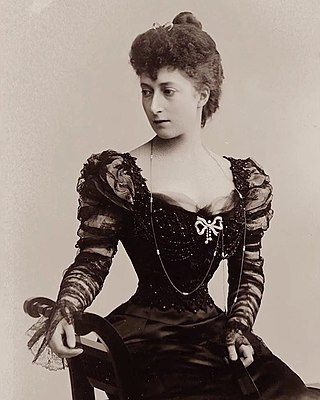
Maud of Wales was Queen of Norway as the wife of King Haakon VII. The youngest daughter of King Edward VII and Queen Alexandra of the United Kingdom, she was known as Princess Maud of Wales before her marriage, as her father was the Prince of Wales at the time.
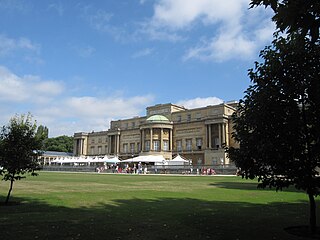
Buckingham Palace Garden is a large private park attached to the London residence of the British monarch. It is situated to the rear (west) of Buckingham Palace, occupying a 17-hectare (42-acre) site in the City of Westminster and forms the largest private garden in London. It is bounded by Constitution Hill to the north, Hyde Park Corner to the west, Grosvenor Place to the south-west, and the Royal Mews, King's Gallery, and Buckingham Palace itself to the south and east.
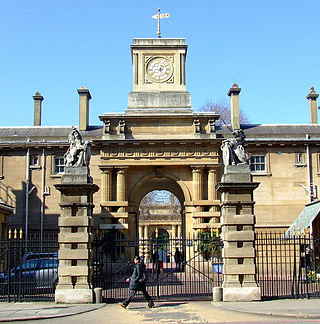
The Royal Mews is a mews, or collection of equestrian stables, of the British royal family. In London these stables and stable-hands' quarters have occupied two main sites in turn, being located at first on the north side of Charing Cross, and then within the grounds of Buckingham Palace.

The Irish State Coach is an enclosed, four-horse-drawn carriage used by the British Royal Family. It is the traditional horse-drawn coach in which the British monarch travels from Buckingham Palace to the Palace of Westminster to formally open the new legislative session of the UK Parliament.

The Gold State Coach is an enclosed, eight-horse-drawn carriage used by the British royal family. Commissioned in 1760 by Francis Rawdon-Hastings, 1st Marquess of Hastings for King George III, and designed by Sir William Chambers, it was built in the London workshops of Samuel Butler. It was commissioned for £7,562. It was built for George III's coronation in 1761, but was not ready in time; it was completed in 1762.
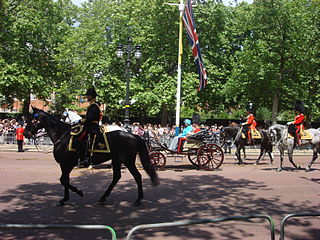
The Crown Equerry is the operational head of the Royal Mews of the Royal Household of the Sovereign of the United Kingdom. As executive head of the Royal Mews Department, he is responsible for the provision of vehicular transport for the sovereign, both cars and horse-drawn carriages. Train travel is arranged by the Royal Travel Office, which also co-ordinates air transport.

The Bentley State Limousines are official state cars manufactured by Bentley as a gift for the late Queen Elizabeth II on the occasion of her Golden Jubilee in 2002. The two cars produced were in service for the Queen up until her death in 2022. They have most recently been in service for King Charles III. The Princess Royal used the car while accompanying the Queen's coffin. Both cars are kept in the Royal Mews.

The Scottish State Coach is an enclosed, four-horse-drawn carriage used by the British Royal Family.

Windsor Grey is a moniker for the grey horses used by the British monarchy to pull carriages and state coaches in ceremonial processions such as those for coronations, royal weddings, Trooping the Colour, and the opening of Parliament. They are named for Windsor Castle where they were originally stabled, though today they live at the Royal Mews near Buckingham Palace.

The Australian State Coach is an enclosed, six horse-drawn coach used by the British Royal Family. Constructed in 1986-88, it was the first royal state coach to have been built since 1902. It was presented to Queen Elizabeth II of Australia and the United Kingdom in Canberra on 8 May 1988, as the official gift on the occasion of the Australian Bicentennial, and was first used in November of that year by the Queen at the State Opening of Parliament in the UK.

The Diamond Jubilee State Coach is an enclosed, six-horse-drawn carriage that was made to commemorate Queen Elizabeth II's 80th birthday, but completion was delayed for nearly eight years. Eventually, it became a commemoration for the Queen's Diamond Jubilee.

Edward VII, King of the United Kingdom of Great Britain and Ireland and Emperor of India, died on Friday 6 May 1910 at the age of 68. His state funeral occurred two weeks later, on 20 May 1910. He was succeeded by his only living son, George V.

In the United Kingdom, state funerals are usually reserved for monarchs. The most recent was the state funeral of Queen Elizabeth II on 19 September 2022.

The Glass Coach is one of the principal State carriages of the British monarch. Built by Peters & Sons of London in 1881, it had originally been designed as a sheriff's coach, but was purchased by the Crown in time for the coronation of George V in 1911.
The State Opening of Parliament includes a State Procession, a formal display of the Sovereign, dignified by a sizeable entourage made up of Great Officers of State and members of the Royal Household. The State Procession is now confined to the interior of the Palace of Westminster, but in earlier centuries it followed an outdoor route to and from Westminster Abbey.

The state and royal cars of the United Kingdom are kept at the Royal Mews, Buckingham Palace, where a wide range of state road vehicles are kept and maintained. The vehicles also are stored at other royal residences as required.
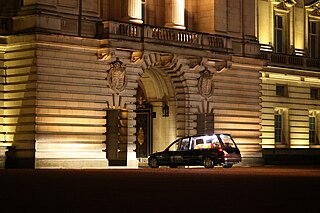
The state hearse is a vehicle of the Royal Mews used for funerals of the British royal family. Based on a Jaguar XJ model, it was designed by the Royal Household and Jaguar Land Rover with the input of and approval from Elizabeth II and converted by UK-based coachbuilders Premiere Sheet Metal, while Wilcox Limousines created the interior, exterior trim and glazing. It was first used on 13 September 2022 to transport Queen Elizabeth II's coffin from RAF Northolt to London ahead of her lying-in-state.





















